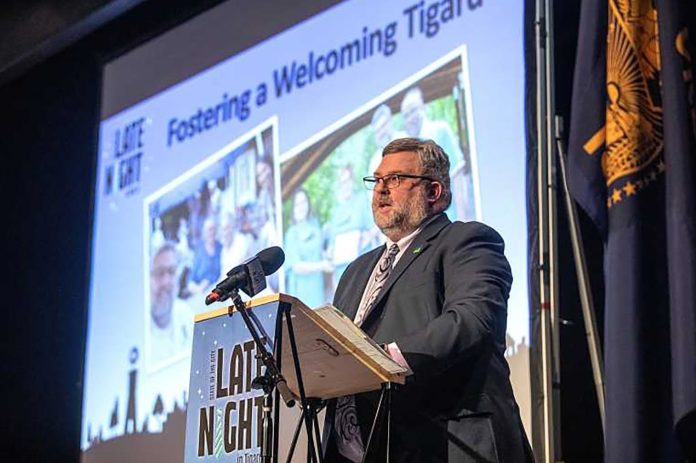In his 2020 State of the City message, Mayor Jason Snider highlighted making Tigard a welcoming community; being responsive to his and the City Council’s 53,148 “bosses” (city residents); spending taxpayers’ money wisely; and providing citizens with “a safe, secure and livable Tigard.”
Snider’s second annual “Late Night in Tigard” theme combined his flair for comedy with straight talk about important city issues.
Tigard already is a welcoming community, and “my personal journey in learning about diversity, equity and inclusion has evolved through several experiences this year,” said Snider, listing several multi-cultural events he attended. He met countless people and heard their stories while new celebrations such as the lighting of a menorah in Liberty Park came to the community.
Snider issued several challenges to the community, and his No. 1 challenge is to make sure “Everyone Counts” in the 2020 Census by partnering with the Census Bureau and Washington County to encourage participation in this year’s census. According to Snider, in 2010 only 79 percent of Tigard residents completed the 2010 census.
As for communicating with all the citizens, Snider set a “big, hairy, audacious” goal of continuing to get “out of City Hall and into your neighborhood.” His No. 2 challenge to everyone is to invite “us to your next neighborhood dinner, business meeting or non-profit event,” and he added, “No event is too small!”
Snider continued, “And just like you, we (the City Council) are better at our job when we get feedback from the 53,148 bosses that we have… Our home base is no longer City Hall. Our home base is every Tigard neighborhood.”
Since last April, council members have attended more than 60 reunions, picnics, celebrations and other events, according to Snider.
On being responsible to taxpayers, Snider touted the report card the city put out on itself that included both the negative (increasing response times for police calls for service) and the positive (increasing the number of affordable housing units in the city).
An outside consultant conducted a citywide performance audit that validated taxpayers’ money is being used wisely and even frugally, and in the three months since the audit was completed, the city has already implemented 12 percent of the recommendations and will continue to increase transparency around city finances, Snider said.
His No. 3 challenge is to ask citizens to email him at jason@tigard-or.gov to share what they want to see in the next report card.
Finally, Snider touted the Tigard Police Department, which currently has 69 sworn officers and in 2019 became a state-accredited law enforcement agency. He relayed the stories of several officers and their heroic responses to challenging situations and thanked them all for “keeping Tigard safe, secure and livable.”
On a personal level, Snider described how his last ride-a-long with a police officer showed him firsthand how “homelessness, mental health and opioids have fundamentally changed the workload,” adding that “these calls take longer and are more difficult to conclude.”
But minimum patrol staffing has remained the same for 25 years, and many officers work overtime.
“From 2010 to 2018, police officer staffing has decreased 4 percent while the population of Tigard increased 13.6 percent and calls for service increased 27 percent,” Snider said. “Quite simply, our patrol officers are tired. This is not sustainable.”
He added, “I hope you all can see, as I do, that without additional officers, a safe, secure and livable Tigard is in jeopardy.”
“We need your help in ensuring our officers have the capacity to respond to multiple emergencies at the same time,” Snider said. “We need your help ensuring some officer time is available for pro-active neighborhood patrols. We need your help in ensuring officers are best equipped to respond to the growing number of mental health calls with advanced de-escalation training.”
Snider’s No. 4 challenge is to share with a neighbor or co-worker the police officers’ inspiring stories he relayed and how officers need community support to keep meeting the needs of the community.
A police services local option levy on the May ballot calls for 29 cents per $1,000 of assessed value, costing the typical Tigard homeowner $6 per month, based on the lower assessed value, not the higher market value of homes.
“According to the audit, eight additional patrol officers and one school resource officer are needed to maintain a safe, secure and livable Tigard (which is what the local option levy would fund),” Snider said. “If you only remember one thing from tonight, I hope it is this.”
But there was far more to the annual event than Snider’s speech. Following the “late night” theme, the event kicked off with “Standby,” a reception in the lobby at the Broadway Rose New Theatre followed by “Showtime” on stage in the theater. The Broadway Rose’s Dan Murphy and Paul Jacobs welcomed everyone and introduced the Tigard Police Department Honor Guard, Thomas Hahn Jr. and Gabe Maldonado, who presented the colors and led the pledge of allegiance.
Maria Pope, CEO of PGE, the event’s sponsor, discussed how the company is transitioning to greener sources of energy. And Snider recapped parts of last year’s “Three Truths and a Lie” game that involved the city councilors and offered his own truths and a lie, handing out prizes to audience members who guessed correctly.
His pre-taped “TV late-night host” segment featuring him interviewing Muwafaq Alkattan, a Washington County outreach organizer and member of Unite Oregon, which is a non-profit organization involving people of color, immigrants and refugees, rural communities and those in poverty working across the state to build a unified intercultural movement for justice.
Next on the late-night couch was Tigard police Chief Kathy McAlpine, who talked about her most memorable experience as a patrol officer in Tacoma and how the understaffed police department copes with the increasing demands of a growing city.
She explained that so far the overtime demands have been filled with volunteers, but officers’ safety can be compromised when they continually work overtime.
“It is worse when it becomes mandatory,” she said. “This is not sustainable. I am ringing the bell about the erosion of service. I’m making a wake-up call. Our officers are facing burn-out, and we are losing our ability to retain them.”
McAlpine pointed out that the department is losing senior officers and that it takes 18-24 months to hire and train a new police officer and can cost up to $350,000. However, she stressed that “we have plenty of dedicated officers.”
Snider’s “Mayor Walking” segment provided both serious moments and laughs as he stood on the sidewalks of Tigard with a microphone and asked citizens about such topics as the Main Street artwork (filbert blossoms, not tulips), their favorite part of Tigard (the small-town community feel), their least-favorite part (traffic), what kind of job they think the mayor is doing, and how many police officers they think are on duty at one time (the answers ranged from 15 to 100).
“Would it be surprising to hear three (police officers)?” Snider asked those who thought the police force apparently numbers in the hundreds.
Finally, Snider listed “the top 10 things I learned my first year as mayor,” including “people will call you when you give out your cell number (503-810-0269).”
And he encouraged the audience to stick around for the blooper reel from the taped segment of the presentation, which everyone did.























